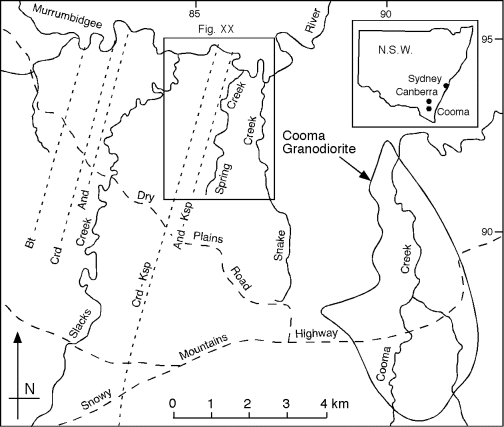
Introduction
The Cooma Complex (Fig. 1) is characterized by an eastwards transition from chlorite slates and phyllites, through biotite-cordierite-andalusite schists to cordierite–K-feldspar–andalusite–K-feldspar gneisses and granofelses, to migmatite. The migmatites have been intruded by the Cooma Granodiorite, which is a peraluminous granitoid with abundant metasedimentary enclaves (Joplin, 1942; Hopwood, 1966; Johnson et. al., 1994). Recent publications on the metamorphic and deformation history of the Cooma Complex include those of Johnson (1992), Johnson et al. (1994), Johnson & Vernon (1995a, 1995b) and Johnson (1999).
Though the metamorphic zonation originally was considered to be of contact metamorphic origin (Browne, 1914; Joplin, 1942), most workers have regarded it as of more regional extent (e.g., Joplin, 1962), though centred around a "regional-aureole" granite, namely the Cooma Granodiorite (White et al., 1974). The extent of the metamorphic rocks suggests that some regional heating must have occurred, even if local magmatic heat was also involved (e.g. Vallance 1953, p. 216).
An unsolved problem is whether the granodiorite is a product of the metamorphism (e.g., Joplin, 1962; Pidgeon & Compston, 1965; White et al., 1974; Munksgaard 1988; Chappell et al. 1991; Ellis & Obata 1992) or whether it has contributed to the metamorphic heat (e.g., Johnson et al. 1994). Most workers have favoured the former interpretation, some suggesting that the granitic magma may have moved upwards for a small distance, though still essentially connected with its source rocks (e.g., Joplin 1962; Vallance, 1967; White et al., 1974; Flood & Vernon, 1978). Chappell & White (1976) and White & Chappell (1988) have put forward chemical evidence that the Cooma Granodiorite represents a partial melt that still contains the solid unmelted metasedimentary residue (restite).
Vallance (1969, p. 185) noted that "Cooma-type" granites occur in rocks of various metamorphic grades in the Lachlan Fold Belt, and that metasedimentary xenoliths in all these granites are of the highest grade metamorphic rocks. Therefore, the granites must have moved from their sources. Vallance (1969, p. 185) suggested that, though the Cooma Granodiorite probably also has moved, it is nearer its source than similar granites in lower grade rocks elsewhere in the region.
The fact that the granodiorite contains only the last foliation (S5) recorded in the metasedimentary rocks (Johnson, 1992; Johnson et al., 1994) indicates that it was intruded late in the metamorphic-deformation history. However, this need not preclude a heat contribution from the granodiorite, as it could have continued to rise after contributing heat to the metamorphic rocks at the present level of exposure (Johnson et al., 1994), and so may have intruded the higher-grade metamorphic zones, as described by the model of den Tex (1963).
In keeping with the interpretation that the Cooma Granodiorite was formed by in situ or practically in situ melting of the adjacent metasediments, Ellis & Obata (1992, p. 95) expressed the popular view that "a progression can be seen in the field from unmelted sediments through migmatites to the granodiorite." In several places (e.g., Soho Street, Cooma and the Snowy Mountains Highway contact) the main granodiorite body (Fig. 1) appears to be gradational into the migmatites, but it also contains sharply bound xenoliths of migmatite identical to the adjacent migmatites (Fig. 4). Further work on the contacts of the main granodiorite mass is required to resolve these apparently contradictory relationships.
This paper attempts to approach the problem by examining the beginning and progression of melting and the relationships of the resulting leucosomes to the first appearance of material resembling the Cooma Granodiorite. Mineral abbreviations are after Kretz (1983).
Fig. 4 Large xenolith of stromatic migmatite enclosed in the Cooma Granodiorite, Soho Street, Cooma. Pocket knife 9 cm long. |
